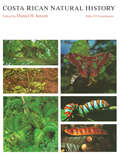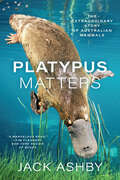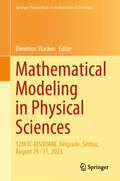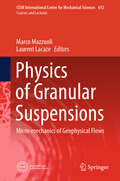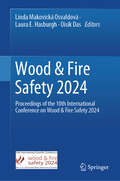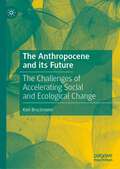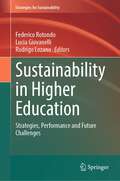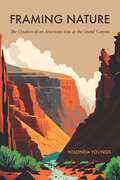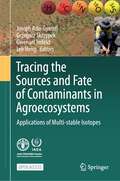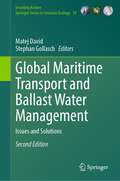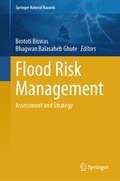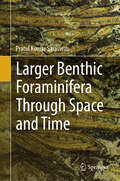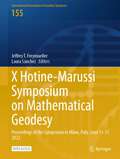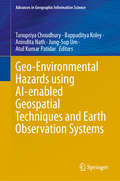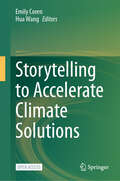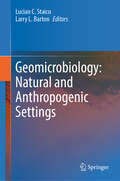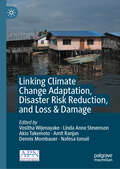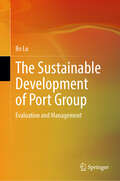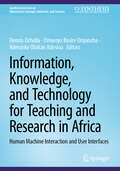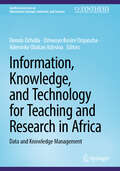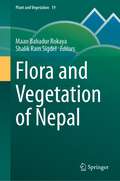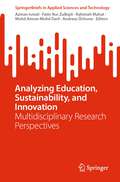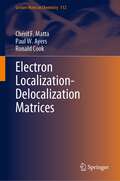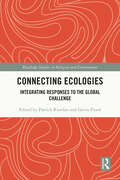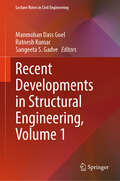- Table View
- List View
Costa Rican Natural History: With 174 Contributors
by Daniel H. JanzenThis volume is a synthesis of existing knowledge about the flora and fauna of Costa Rica. The major portion of the book consists of detailed accounts of agricultural species, vegetation, amphibians, reptiles, mammals, birds, and insects. "This is an extraordinary, virtually unique work. . . . The tremendous amount of original, previously unpublished, firsthand information is remarkable."—Peter H. Raven, Director, Missouri Botanical Garden "An essential resource for anyone interested in tropical biology. . . . It can be used both as an encyclopedia—a source of facts on specific organisms—and as a source of ideas and generalizations about tropical ecology."—Alan P. Smith, Ecology
Platypus Matters: The Extraordinary Story of Australian Mammals
by Jack AshbyScientifically informed and funny, a firsthand account of Australia’s wonderfully unique mammals—and how our perceptions impact their future. Think of a platypus: They lay eggs (that hatch into so-called platypups), produce milk without nipples and venom without fangs, and can detect electricity. Or a wombat: Their teeth never stop growing, they poop cubes, and they defend themselves with reinforced rears. And what about antechinuses—tiny marsupial carnivores whose males don’t see their first birthday, as their frenzied sex lives take so much energy that their immune systems fail? Platypuses, possums, wombats, echidnas, devils, kangaroos, quolls, dibblers, dunnarts, kowaris: Australia has some truly astonishing mammals, with incredible, unfamiliar features. But how does the world regard these creatures? And what does that mean for their conservation? In Platypus Matters, naturalist Jack Ashby shares his love for these often-misunderstood animals. Informed by his own experiences meeting living marsupials and egg-laying mammals during fieldwork in Tasmania and mainland Australia, as well as his work with thousands of zoological specimens collected for museums over the last two-hundred-plus years, Ashby’s tale not only explains historical mysteries and debunks myths (especially about the platypus), but also reveals the toll these myths can take. Ashby makes clear that calling these animals “weird” or “primitive”—or incorrectly implying that Australia is an “evolutionary backwater,” a perception that can be traced back to the country’s colonial history—has undermined conservation: Australia now has the worst mammal extinction rate of any place on Earth. Important, timely, and written with humor and wisdom by a scientist and self-described platypus nerd, this celebration of Australian wildlife will open eyes and change minds about how we contemplate and interact with the natural world—everywhere.
Mathematical Modeling in Physical Sciences: 12th IC-MSQUARE, Belgrade, Serbia, August 28–31, 2023 (Springer Proceedings in Mathematics & Statistics #446)
by Dimitrios VlachosThis volume gathers selected papers presented at the ICMSQUARE 2023 - 12th International Conference on Mathematical Modeling in Physical Sciences held in Belgrade, Serbia from August 28–31, 2023. This proceedings offers a compilation of cutting-edge research, which aims to advance the knowledge and development of high-quality research in mathematical fields related to physics, chemistry, biology, medicine, economics, environmental sciences, and more. Annually held since 2012, the ICMSQUARE conference serves as a platform for the exchange of ideas and discussions on the latest technological trends in these fields. This book is an invaluable resource for researchers, academicians, and professionals in these areas seeking to stay up-to-date with the latest developments in mathematical modeling.
Physics of Granular Suspensions: Micro-mechanics of Geophysical Flows (CISM International Centre for Mechanical Sciences #612)
by Marco Mazzuoli Laurent LacazeThis book provides graduate students and scientists with fundamental knowledge on the mechanics of granular suspensions as well as on the mathematical and numerical techniques that can be adopted to investigate geophysical flows. To this end, three formidably complex problems (sediment transport, flow-like landslide inception, and gravity currents) are considered. The reader will find a thorough combination of elements of fluid and solid mechanics, rheology, geotechnics, geomorphology, civil, and coastal engineering. The first part of the book introduces the problem of granular suspensions from the mathematical viewpoint, focusing on issues that characterise geophysical flows such as turbulence, the effects of inter-particle contacts, and strong velocity gradients. In the second part, different models that were successfully used to investigate the mechanics of granular suspensions in environmental flows are presented.
Wood & Fire Safety 2024: Proceedings of the 10th International Conference on Wood & Fire Safety 2024
by Oisik Das Linda Makovická Osvaldová Laura E. HasburghThis proceedings volume presents new scientific works of the research workers and experts in the field of Wood Science & Fire.It looks into the properties of various tree species across the continents affecting the fire-technical properties of wood and wood-based materials, its modifications, fire-retardant methods and other technological processes that have an impact on wood ignition and burning. The results of these findings have a direct impact on Building Construction and Design describing the fire safety of wooden buildings, mainly large and multi-story ones. The results of these experiments and findings may be applied, or are directly implemented into Fire Science, Hazard Control, Building Safety which makes the application of wood and wood materials in buildings possible, while maintaining strict fire regulations.One part of the contributions focuses on the symbiosis of the material and the fire-fighting technologies. Wood burning has its own specific features, therefore, the fire protection technologies need to be updated regularly. It also includes the issue of the intervention of fire-fighting and rescue teams in the fires of wooden buildings. Presentations deal with the issue of forest fires influenced by the climate changes, relief, fuel models based on the type and the age of the forest stand.
The Anthropocene and its Future: The Challenges of Accelerating Social and Ecological Change
by Karl BruckmeierThis book analyses the complex social and ecological processes of the Great Acceleration, the Great Transformation, and sustainable development that shape the future of the global society in the twenty-first century. The first process takes place for a longer time, the second over the past thirty years, with attempts to build a sustainable economy and society in the global policy of sustainable development. The processes and their interaction will be discussed with knowledge from inter- and transdisciplinary transformation research, social and political ecology, and theories of modern society. The guiding theoretical concepts for the social-ecological transformation will be clarified: the concepts of acceleration, transformation, and sustainable development, and the societal and ecological processes they include. To obtain a more detailed picture of the changes in the global social-ecological system, different parts of the global transformation, the digital transformation, the transformation of food systems, and the transformation of modes of living in the social lifeworld are described to show the complex changes in the epoch of the Anthropocene more concretely. The global change processes in society and nature are caused by human forces but are difficult to control through policy and governance. With the interdisciplinary integration of concepts and knowledge, it becomes possible to provide a more detailed picture, of the difficulties to achieve a sustainable future society.
Sustainability in Higher Education: Strategies, Performance and Future Challenges (Strategies for Sustainability)
by Rodrigo Lozano Federico Rotondo Lucia GiovanelliThis contributed volume addresses the issue of how higher education institutions can systematically reorient themselves to help society become more sustainable. In particular, a strategic management approach is used to overcome the fragmentation of sustainability initiatives increasingly conducted by higher education institutions worldwide. In this book, eminent scholars in the field of sustainability in higher education combine their different backgrounds to propose conceptual frameworks for interpreting and measuring sustainability integration in higher education institutions. The chapters contained herein explore which processes and management tools should be used, as well the challenges to be faced, to make sustainable innovation effective. The cases present in this volume offer a guide for higher education institution management to lead the sustainability transition.
Framing Nature: The Creation of an American Icon at the Grand Canyon (America’s Public Lands)
by Yolonda YoungsThe Grand Canyon of the Colorado River is an internationally known feature of the North American landscape, attracting more than five million visitors each year. A deep cultural, visual, and social history has shaped the Grand Canyon&’s environment into one of America&’s most significant representations of nature. Yet the canyon is more than a vacation destination, a movie backdrop, or a scenic viewpoint; it is a real place as well as an abstraction easily summoned in the minds of Americans. The Grand Canyon, or the idea of it, is woven into the fabric of American cultural identity and serves as a cultural reference point—an icon. In Framing Nature Yolonda Youngs traces the idea of the Grand Canyon as an icon and the ways people came to know it through popular imagery and visual media. She analyzes and interprets more than fourteen hundred visual artifacts, including postcards, maps, magazine illustrations, and photographs of the Grand Canyon, supplemented with the words and ideas of writers, artists, explorers, and other media makers from 1869 to 2022. Youngs considers the manipulation and commodification of visual representations and shifting ideas, values, and meanings of nature, exploring the interplay between humans and their environments and how visual representations shape popular ideas and meanings about national parks and the American West. Framing Nature provides a novel interpretation of how places, especially national parks, are transformed into national and environmental symbols.
Tracing the Sources and Fate of Contaminants in Agroecosystems: Applications of Multi-stable Isotopes
by Lee Heng Joseph Adu-Gyamfi Grzegorz Skrzypek Gwenaël ImfeldThe objective of this open access book is to present protocols, methodologies, and standard operating procedures (SOPs) used for the identification of sources, transport, and fate of agro-contaminants and illustrate them with several case studies of successful applications. The Soil and Water Management & Crop Nutrition (SWMCN) Subprogramme of the Joint Food and Agriculture Organization (FAO)/International Atomic Energy Agency (IAEA) Centre of Nuclear Techniques in Food and Agriculture, through a Coordinated Research Project (CRP) in partnership with national and international research institutes, developed and evaluated a set of analytical techniques (the toolbox). The toolbox integrates multiple isotope tracers that provide information on the origins and pathways of multiple pollutants through agro-ecosystems, thereby providing more accurate guidance on mitigations. However, land management strategies to address and control the transport of pollutants from soil to water bodies remain the shared responsibility of farm and aquaculture operators, agro-chemical manufacturers, and policymakers in food and agriculture as well as the mining sectors. This book is structured into eight chapters covering (i) an overview of the book’s content, (ii) guidelines for designing water sampling programmes, (iii) the use of mixing models applicable to tracers for water pollution studies, (iv) compound-specific isotope analyses to investigate pesticide degradation in agricultural catchments, (v) the use of stable oxygen isotope composition of phosphate to investigate phosphorous in soil-plant continuum, (vi) the use of stable sulphur isotopes to disentangle agro-pollutants from other contaminants, (vii) nuclear tools used in sediment source apportionment, and (viii) the conclusions and perspectives forward. The book offers up-to-date information, and we hope it is a great source of information for students, researchers, and policymakers. The SWMCN subprogramme thanks all the contributors involved in the preparation of this publication.
Global Maritime Transport and Ballast Water Management: Issues and Solutions (Invading Nature - Springer Series in Invasion Ecology #16)
by Matej David Stephan GollaschIn 2015 the first edition of this book was published before the Ballast Water Management (BWM) Convention entered into force. To our knowledge this was and still is the first comprehensive book on BWM worldwide. It provided an overview of possible solutions to the complex issue of BWM. It further outlined consequences and implications to address the ballast water "problem" in line with provisions of the BWM Convention considering environmental, shipping, legal and policy perspectives. The previously addressed subjects remain essential, but new subjects appeared which more recently have proven to be critical for the effective BWM Convention implementation. After the first book content was already agreed and in preparation, new advances were achieved in BWM-related research around the world. Further, new experience was gained and issues came out during the preparation processes of countries for the BWM Convention implementation. The editors of the first book remained heavily involved in BWM-related research and other processes, hence these new critical BWM issues and subjects are now dealt with in the second edition of this book to complement the first one. In essence, this new book covers main issues that arose recently during the implementation of the BWM Convention. Scientists and experts with extensive experience in these subjects from around the globe from academic and private sectors, as well as national administrations, were involved in the preparation of this book.
Flood Risk Management: Assessment and Strategy (Springer Natural Hazards)
by Brototi Biswas Bhagwan Balasaheb GhuteThis book examines the nature of flood in different landscapes and the various factors that contribute to flooding in different areas. It identifies flood risk zones in different terrain types and provides valuable insights into the anthropogenic, geographical, hydro-geological, and geomorphological aspects of flood-prone areas to achieve sustainable risk management. The book also explores the impact of avalanches, global warming, and flash floods in different settings where such types of flooding have become more common. In addition, the volume provides case studies to evaluate the impact of flooding in both natural and man-made environments. To better understand and manage floods, the book combines advanced geospatial tools and techniques with indigenous knowledge. Using machine learning and multiple-criteria decision analysis, the book provides an amalgamation of technology and indigenous knowledge to assess flood susceptibility. The book also includes strategies to manage flood risks and case studies that demonstrate best practices in flood risk management. The volume is a valuable resource for researchers, students, and policy makers to understand the causes of floods and their socio-economic impact in different areas.
Larger Benthic Foraminifera Through Space and Time
by Pratul Kumar SaraswatiForaminifera are single-celled marine organisms, usually less than a millimeter in size, and their fossil records extend back in geological time some 500 million years. Some foraminifera have grown to over 10 centimeters; these are informally called "larger benthic Foraminifera" (LBF). LBF are of outstanding value in field and in laboratory experiments. They can serve as geochemical proxies and can be used to learn about biology, biomineralization process, and more. Their study finds wide-ranging geological applications, including the carbonate platforms' past environmental changes and stratigraphy. There are many books on micropaleontology, fewer on Foraminifera and practically none on LBF. The ones that do exist are generally too specialized for micropaleontology and carbonate sedimentology doctoral students to utilize. This volume aims to fill this gap by providing readers with an understanding of the morphology and distribution of LBF in space (environment) and time (evolution). In addition, the isotope and trace metal proxies in LBF are discussed for paleoclimate reconstruction. This volume will benefit researchers and professionals in micropaleontology, hydrocarbon exploration, carbonate sedimentology, and paleoclimate.
X Hotine-Marussi Symposium on Mathematical Geodesy: Proceedings of the Symposium in Milan, Italy, June 13-17, 2022 (International Association of Geodesy Symposia #155)
by Jeffrey T. Freymueller Laura SánchezThis open access volume contains the proceedings of the X Hotine-Marussi Symposium on Mathematical Geodesy which was held from 13 to 17 June 2022 at the Politecnico di Milano, Milan, Italy. Since 2006 the series of the Hotine-Marussi Symposia has been under the responsibility of the Inter-Commission Committee on Theory (ICCT) within the International Association of Geodesy (IAG). The ICCT organized the last five Hotine-Marussi Symposia held in Wuhan (2006), Rome (2009, 2013 and 2018), and Milan (2022). The overall goal of the ICCT and Hotine-Marussi Symposia has always been to advance geodetic theory which is indeed documented by the 22 research articles published in these proceedings. The jubilee X Hotine-Marussi Symposium was organized in 10 topical sessions covering all parts of geodetic theory including reference frames, gravity field modelling, adjustment theory, height systems, time series analysis, or advanced numerical methods. In total, 60 participants attended the Symposium who delivered 62 oral and 18 poster presentations. During a special session, five invited speakers discussed two basic concepts of physical geodesy – geoid and quasigeoid.
Geo-Environmental Hazards using AI-enabled Geospatial Techniques and Earth Observation Systems (Advances in Geographic Information Science)
by Jung-Sup Um Tanupriya Choudhury Bappaditya Koley Anindita Nath Atul Kumar PatidarThis edited collection provides a comprehensive exploration of cutting-edge ideas, approaches, simulations, evaluations of risk, and systems that enhance the practicality of current geospatial technologies for reducing hazard risks. The various sections within this book delve into subjects such as the foundational principles of Earth Observation Systems (EOS) and geospatial methodologies. Additionally, the text serves as an advisory resource on the collaborative use of satellite-derived data and artificial intelligence to track and alleviate geo-environmental threats. The volume imparts extensive understanding regarding geo-environmental dangers and their analysis via EOS along with geospatial strategies. It encompasses key hazard-related themes including coastal degradation, predisposition to landslides, mapping vegetation coverages, tropical storm patterns, soil depletion due to erosion processes, vulnerability to rapid or extended flooding events, variations in oceansurface temperatures alongside chlorophyll-a levels; it also addresses assessments related to groundwater reserves and quality measures as well as sustainable management practices for watersheds that support community livelihoods—all through leveraging AI-integrated geospatial tools in conjunction with earth observation technologies. Furthermore, this work engages in discourse about systems designed for mitigating these ecological challenges sustainably. Scholars engaged in research activities; educational professionals; those involved in landscape design; engineers working at ground level; individuals responsible for policy-making—all who are concerned with geo-environmental hazards or associated domains—will find valuable insights within these pages.
Storytelling to Accelerate Climate Solutions
by Hua Wang Emily CorenThe climate is changing faster than our cultural practices are adapting to it. This Open Access volume, co-edited by Emily Coren (a science communicator) and Hua Wang (a communication scientist), presents a survey of the latest in agency-focused climate storytelling. Together, practitioners and scholars across different fields shared their knowledge, experience, and insight about how stories can be designed and told to engage, enable, and empower individuals and communities in climate communication and action. You will learn a wide range of narrative strategies and exemplary applications of climate storytelling in terms of professional practices (e.g., education, literature, journalism, popular media), genres and formats (e.g., drama, comedy, fiction), media platforms (e.g., television, radio, mobile), and communication modalities (e.g., text, visual, audio, multisensory). Entertainment-education has been proven over decades to be an effective tool for social and behavior change in the public health sphere and has not yet been applied at scale to the massive ongoing climate–related disasters that we need to solve now, fast. There is an urgent need to rapidly apply and adapt public engagement tools for climate communication to speed up our response times for climate change mitigation and adaptation. This book takes a snapshot of where climate storytelling is currently at, describes where it fits within a climate communication landscape, and supports the next steps of its development. It facilitates the of creation climate storytelling efficiently by sharing and amplifying what is working well, and building collaborations between practitioners and researchers.This is an open access book.
Geomicrobiology: Natural and Anthropogenic Settings
by Larry L. Barton Lucian C. StaicuThis volume brings together leading international experts to offer a unique and timely perspective on geomicrobiology through their latest research and findings. Chapters address interactions of marine and freshwater microorganisms contributing to geochemical cycles, including biochemical mechanisms for mineralization and transformation of solid minerals and dissolved metals. In addition, the resilience and physiological elasticity of specific bacteria in extreme environments is discussed, such as mechanisms of metal homeostasis and electrochemistry involving extracellular electron flow. Further coverage includes resource recovery (metals, minerals) using microbial-driven processes and technologies, with the aim to contribute to a better understanding of microbial potential within the framework of circular economy. This book is designed for professionals and students, including environmental engineers, microbiologists, and individuals studying the interaction of bacteria with metals and minerals in the environment. It is also a resource for students in academic programs or short courses focused on bacterial diversity in the environment, systems of bacterial energetics, resource recovery, and bacterial activities in extreme or nutrient-stressed environments. .
Linking Climate Change Adaptation, Disaster Risk Reduction, and Loss & Damage
by Linda Anne Stevenson Amit Ranjan Dennis Mombauer Vositha Wijenayake Akio Takemoto Nafesa IsmailThis book advances knowledge on loss & damage (L&D) and its interlinkages with climate adaptation and disaster risk reduction. The book includes twelve case studies conducted across South and Southeast Asia, covering sectors including agriculture, rural livelihoods, energy, infrastructure and natural resources. These studies provide insights into complex climate-induced L&D, enhancing local, national and regional knowledge and contributing to global agendas.
The Sustainable Development of Port Group: Evaluation and Management
by Bo LuThis book primarily focuses on the coordinated development of port groups and the environment. It extensively reviews relevant literature and draw on existing theoretical research achievements to analyze the mechanisms and influencing factors behind the formation of green, ecological, or energy-saving ports. It employs attribution decomposition analysis and LMDI decomposition methods to identify driving forces and factors for low-carbon ports. Furthermore, with the goal of minimizing the comprehensive cost of low-carbon port investment and considering constraints such as the upper limit of low-carbon investment in ports, the book utilizes tools such as stochastic processes and optimization decision theory to establish an optimization model for carbon emission reduction investment in low-carbon ports, aiming to find the best investment solution. Throughout the process, the book employs a combination of quantitative and qualitative analysis methods and provides corresponding recommendations and suggestions from an industry and port perspective through comparative analysis and case studies.
Information, Knowledge, and Technology for Teaching and Research in Africa: Human Machine Interaction and User Interfaces (Synthesis Lectures on Information Concepts, Retrieval, and Services)
by Dennis Ocholla Omwoyo Bosire Onyancha Aderonke Olaitan AdesinaThis book focuses on human machine interaction and user interfaces for teaching and research in Africa. The importance of digital humanities (DH) is recognized by focusing on the theoretical and historical development of DH in the context of LIS education and how infrastructure influences DH programs/initiatives in respective LIS schools. These findings and recommendations provide valuable knowledge for developing the domain and establishing potential areas of collaboration in DH research and curriculum. The book explores and explicates what the Diffusion of Innovations theory is about as well as the characteristics of innovators. The Diffusion of Innovations theory is relevant to the LIS field, which has widely adopted numerous innovations to automate a wide range of administrative and technical processes, build databases and networks, and provide better services to library users. The diffusion and adoption of technology have become imperative for the efficient management ofmodern libraries and LIS as a field in general. Existing literature that is related to the adoption, use, and challenges facing the development of clinical informatics in teaching hospitals in developing countries is reviewed. It is also revealed that hospitals in developing countries should embrace the use of tools for effective healthcare delivery and that nursing informatics is very significant in nursing practice. In addition, the role of academic institutions and the use of information and communication technologies (ICTs) by librarians for information and knowledge (IKM) in such institutions in the Fourth Industrial Revolution (4IR) is addressed. The book acknowledges the marginalization of indigenous knowledge and that there is a need for Africa to develop and accelerate strategies for enhancing indigenous knowledge for future generation and ICT is poised to play a crucial role.
Information, Knowledge, and Technology for Teaching and Research in Africa: Data and Knowledge Management (Synthesis Lectures on Information Concepts, Retrieval, and Services)
by Dennis Ocholla Omwoyo Bosire Onyancha Aderonke Olaitan AdesinaThis book focuses on data and knowledge management for teaching and research in Africa. The importance of the information and knowledge society in current times is recognized and adopts a meta-analysis to demonstrate that modernization theory could be applied to economic development and rapid transformation of ISWEs in South Africa. The book argues that modernity and the information and knowledge society present the shift and transition from the traditional way of doing things through information and communication technologies (ICTs), which could bring about developing, progressing, and advancing developing communities, particularly Informal Sector Women Entrepreneurs (ISWEs). The book also has further shows how the modernization theory could be applied to the plight of ISWEs to assist them in leapfrogging from their situation and enjoying global business platforms. Various techniques and strategies for collaborative engagements among academics towards strengthening scholarly ties within institutions, and across borders, especially in Africa, are presented. This is a valuable source for understanding the contemporary issues in information and knowledge management/sharing and collaboration among university academics for undergraduates and postgraduate students in the library and information science profession. Tacit knowledge is also presented as an asset that boosts innovation and generates competitive advantage for organizations in all walks of life. Global research data management (RDM) literature is emphasized in higher education institutions (HIEs) and their libraries. The status of RDM services, as well as the competency requirements of employees responsible for providing RDM services and researchers, are addressed in the examined literature.
Flora and Vegetation of Nepal (Plant and Vegetation #19)
by Maan Bahadur Rokaya Shalik Ram SigdelThis volume highlights the plant life of Nepal, which accounts for 20% of the Himalayan biodiversity. For the first time, this group of authors compile over 200 years’ worth of local botanical research. Due to the high topographical diversity, Nepal has a very unique flora and vegetation. The chapters focus on cryptogams, phanerogams and alien flora. As an added bonus, historical background for native and invasive species, is explained. Aside from botanical knowledge, the authors also shed a light on Nepali geography, soil, climate and land use. To complete the picture, readers will find data on different plants, maps and photographs of unique species. This book is a valuable resource for Botanists and Ecologists, but also for interested travelers who would like to complement their next trek in Nepal.
Analyzing Education, Sustainability, and Innovation: Multidisciplinary Research Perspectives (SpringerBriefs in Applied Sciences and Technology)
by Andreas Öchsner Azman Ismail Mohd Amran Mohd Daril Fatin Nur Zulkipli Rahimah MahatThis book describes a diverse array of studies unravelling the intricate interplay of education, sustainability, and organizational dynamics. From innovative teaching methodologies to sustainability trends and the pandemic's impact, this compendium offers a rich tapestry of insights. This book traverses through a compendium of studies that intricately dissect the synergy between education, sustainability, and organizational dynamics. This book is ideal for academics, practitioners, and curious minds seeking a deeper understanding of these vital contemporary forces.
Electron Localization-Delocalization Matrices (Lecture Notes in Chemistry #112)
by Chérif F. Matta Ronald Cook Paul W. AyersThis book builds bridges between two yet separated branches of theoretical and mathematical chemistry: Chemical Graph Theory and Electronic Structure Calculations. Although either of the fields have developed their own techniques, problems, methods, and favorite benchmark cases independent from each other, the authors have managed to bring them together by using the localization-delocalization matrix (LDM). The LDM is a novel molecular descriptor that fingerprints a molecule by condensing the complicated electronic information in one, mathematically manageable, object. In this book, the authors introduce the readers to modeling techniques based on LDMs. Their technique offers a high accuracy as well as robust predictive power, often dramatically surpassing the potential of either of the constituting methods on their own. In addition to the comprehensive and accessible introduction to this new field of theoretical chemistry, the authors offer their self-developed software free to download, so that readers can try running their own simulations. The described methods are very general and can easily be implemented for calculating various properties and parameters such as mosquito repelling activity, ionic liquid properties, local aromaticity of ring molecules, log P's, pKa's, LD50, corrosion inhibition activities, and Lewis acidities and basicities – to only name a few. The free downloadable software helps readers automate the analysis of the matrices described in this book and hence facilitates application of the described methodology.
Connecting Ecologies: Integrating Responses to the Global Challenge (Routledge Studies in Religion and Environment)
by Gavin Flood Patrick RiordanConnecting Ecologies focuses on the environmental aspects of Pope Francis’ encyclical Laudato Si’ and the challenge to care for our common home. It considers how best to devise and implement the new societal models needed to tackle the ecological problems facing the world today. The book addresses the need for and complexity of an integral ecology, one that looks not only at physical and biological processes but also allows for the contributions of theology, philosophy, spirituality, and psychology, including the implications for the human and social sciences. The contributions document four categories of resonances, resources, requirements, and responses evoked by a reading of Laudato Si’ and include consideration of other faith traditions. They reflect on how care for our common home motivates people in different places, cultures, and professions to cooperate for myriad goods in common. The volume is particularly relevant for scholars working in religious studies and theology with an interest in ecology, the environment, and the Anthropocene.
Recent Developments in Structural Engineering, Volume 1 (Lecture Notes in Civil Engineering #52)
by Ratnesh Kumar Manmohan Dass Goel Sangeeta S. GadveThe book presents the select proceedings of 13th Structural Engineering Convention. It covers the latest research in multidisciplinary areas within structural engineering. Various topics covered include structural dynamics, structural mechanics, finite element methods, structural vibration control, advanced cementitious and composite materials, bridge engineering, soil-structure interaction, blast, impact, fire, material and many more. The book will be a useful reference material for structural engineering researchers and practicing engineers.
